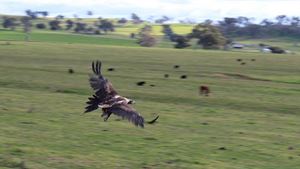Wedge-tailed eagle rescued and released
Tuesday, April 1, 2014

A farmer inspecting his property on the north coast of NSW late one afternoon, discovered a Wedge-tailed eagle on the ground. It appeared very weak and ill, so he took it home and called WIRES. Because of the late hour, he promised to keep it quiet and dark, and take it to the vet first thing in the morning.
The wonderful Macksville Vet examined the eagle and found a bullet hole in a wing muscle. By sheer luck, no bone had been broken or exposed. Due to shock, blood loss, and the fall (possibly from a great height) the bird was extremely ill and could not stand, in fact, could not even raise its head. It was given injections of rehydration fluid, then x-rayed later that day.
Then WIRES volunteer, Janet of Mid North Coast WIRES, collected the eagle, with its antibiotics and analgesia. The next morning Janet crop-fed the wedge-tail with rehydration fluid, administered antibiotics and pain relief and resettled the bird in its support equipment. Janet was encouraged when the eagle began holding its head up.
When it started looking brighter, Janet gave it some small pieces of meat, which it was able to swallow. The wound was inspected and cleaned regularly, and Janet continued to administer medication.
Imagine the scene: a massive bird of prey, with talons the size of dress-maker’s scissors, a beak the size of a giant antique tin-opener and a wing-span of 2 metres, needing medications and food. Janet was calm, confident – and did it. Many times on those first days, the bird was fed small amounts, and its bedding changed.
Recent Posts
WIRES launches its first wildlife rehabilitation centre - Mullyang
WIRES Emergency Response in the wake of ex-tropical cyclone Alfred
International Women’s Day Volunteer Spotlight: Shelley
Tropical Cyclone Alfred – Emergency Wildlife Advice
Interview with WIRES Training and Development
Celebrating Women in Science: The Journey of Holly, Wildlife Conservationist and WIRES Team Member
